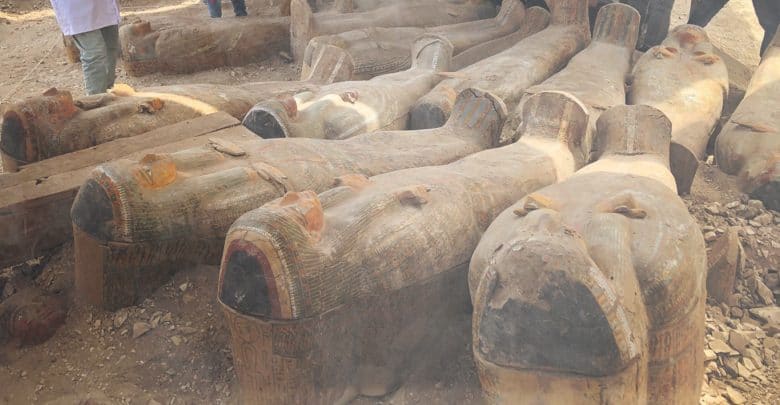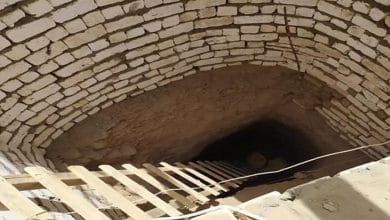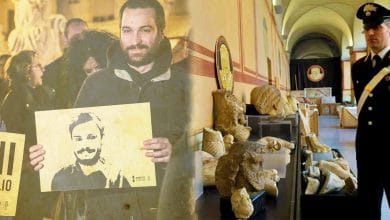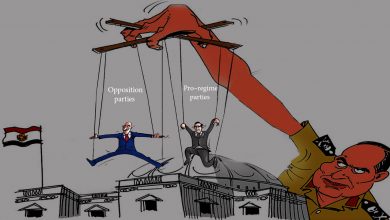
The announcement of one of the biggest and most important archaeological discoveries of the past 100 years, as described by the Ministry of Antiquities, continues to preoccupy specialists and those concerned in archaeological discoveries – reflecting various opinions and viewpoints. This report attempts to discuss views and opinions related to the Asasif Cemetery coffins objectively with no prejudice to one opinion or another.
The report is divided into three prospects; the first one introduces the event as it was stated by the Ministry of Antiquities; the second analyzes the divergent views of scientists and academics regarding the event; and the third introduces the writer’s findings, supported by reliable historical facts.
1) The event as stated by officials
The official discovery of an archaeological cache in the Asasif Cemetery on Luxor’s west bank was announced on Saturday, October 19 at a major press conference attended by many foreign media – although it was covered by only two Egyptian media outlets – where the Egyptian antiquities minister, Khaled El-Enany, said during a ceremony in Luxor, “It is the first large human coffin cache ever discovered since the end of the 19th century.”
According to the Egyptian archaeologists who discovered the coffins, the cache included a “distinctive group of 30 colored wooden coffins for priests and priestesses, and children” who served the gods Amun and Khonsu three thousand years ago. These coffins were preserved from the moment they were left completely closed with mummies inside in two compartments within the cemetery; the first including 12 coffins and the second including18 coffins. The coffins that were in a good condition of preservation, colors and complete inscriptions, provide evidence of the different stages of how coffins were made during that period, where some of the coffins were fully colored painted while others were in the early stages of manufacturing.
One of the mission members stated that the Asasif cemetery includes tombs dating back to the rule of the 18th., 22nd. and 25th. Pharaonic dynasties from 1550 to 525 BC. Previous discoveries in this area included two caches of royal mummies; the Deir el-Bahri mummy cache discovered in 1881, and another cache found inside the tomb of King Amenhotep II KV35 in 1898 and the cache of Bab al-Jisus in 1891, where dozens of mummies for priests were found.
2) Analysis of divergent views
The comments made by officials and specialists on the event, as well as different and divergent views of scientists and academics, undoubtedly makes the whole matter questionable, for the following reasons:
1- The numbers of coffins declared were contradictory from the early moments: while the ministry’s statement stated that more than 20 wooden coffins in excellent condition were discovered, Dr. Khaled El-Enany, Minister of Antiquities, stated that the cache included a distinct group of 30 wooden coffins of men, women and children, in a good condition of preservation, colors and complete inscriptions. Although it was not difficult to pinpoint the number of coffins from the beginning, the difference between the two figures is large.
2- Dr. Mohamed Abdel-Maksoud, the former Secretary General of the Supreme Council of Antiquities, referred in a press statement to the cache as a disclosure rather than a discovery, and addressed a number of questions to officials, including: Why were these coffins kept in a hole covered with sand? Why weren’t they put in a cemetery? Who are these coffins for? Where is the original cemetery of these coffins? Why were they placed in front of the cemetery 33, which was used as a warehouse for storing antiquities during the 1967 War? Abdel-Maksoud also confirmed that the transfer and storage of antiquities in 1967, is true and documented in the Ministry of Antiquities records.
But the minister of antiquities quickly denounced the remarks of Dr. Mohamed Abdel-Maksoud, saying that the rumors about the discovery of these coffins since 1967, is completely groundless. The minister added that coffins used to be stored in tombs, but the coffins of this discovery were found inside the mountain.
3- Dr. Ahmed Eissa, professor of Egyptian Antiquities at Cairo University, stated on his personal Facebook page that the owner of the house where the coffins were discovered, Ali Ahmed Awad, was working for the Ministry of Antiquities. Dr. Eissa also stated that the whole area, including Awad’s house, was expropriated and evacuated from population since 2007 for likely existence of antiquities. Dr. Ahmed Eissa also noted that foreign missions had operated in the area before and conducted palpation operations, including palpation carried out by an American researcher, Pechkova.
4- Dr. Mohamed Mustafa Al-Saghir, Director of the Karnak Antiquities, also questioned the ministry’s account on the discovery, saying that the real determinant in this argument will be the outcome of excavations and examinations of layers of soil surrounding the coffins, which will reveal the burial conditions, noting that the burial process in this way shows that the place was not the primary burial site.
5- While the Secretary-General of the Supreme Council of Antiquities, Mustafa Al-Waziri, declared that his mission had been operating in the area for more than two months; a source from the same mission revealed that the discovery came by chance, adding that while workers were lifting piles of dust to prepare the site for digging for antiquities, they all of a sudden found the coffins.
6- The discovery was declared by an Egyptian archaeological mission as most of the discoveries announced in recent years; however, the Egyptian missions that work in excavations do not exceed eight missions, while the number of foreign missions operating in Egypt exceeds 250 missions that have been working for decades. It is strange enough, however, that these foreign missions have not announced any discoveries of this size as the Egyptian missions have done.
7- The statements of officials of the Ministry of Antiquities about the number of Egyptian missions operating in excavations are contradictory. The minister announced that “for the first time, about 50 Egyptian missions are operating in excavations throughout Egypt”, although he, himself, had said that there are currently 80 Egyptian archaeological missions operating in Egypt, representing one third of the whole number of these missions. Meanwhile, the Secretary General of the Ministry of Antiquities said that the number of Egyptian missions carrying out excavations in archaeological sites in various governorates of Egypt rose from five to 40 Egyptian archaeological missions.
8- It is also doubtful that the name of current Secretary General of the Supreme Council of Antiquities, Dr. Mustafa Al-Waziri – a student of Dr. Zahi Hawass, by the way – has frequently been mentioned in the media in a remarkable and excessive way. Al-Waziri used to work in the area of Qurna, west of Luxor, and has been in charge of the same area for several years; therefore, he is well aware of the details of the area, which makes recurrence of his name as associated with new discoveries of antiquities, by the ministry, questionable.
9- With the remarkable increase in declared archaeological discoveries in recent years, that we hope to be true, makes us doubtful about their authenticity, especially that statements and actions of the Ministry of Antiquities officials in recent years have become closer to political statements than scientific or professional statements. Late last year, the minister announced that the year 2019 would be the year of archaeological discoveries. The minister, during inauguration of the development work at the Tal Basta Museum in Sharqia Governorate, also declared that the year 2018 would be a year of inaugurations and archaeological discoveries. Anyway, there are similar statements that are repeated every year about new discoveries, which raises a significant question, namely: how does the Ministry of Antiquities know that the ‘coming year’ will be a year of archaeological discoveries? Does it make sense that the same statement is repeatedly said year after year?
10- The Minister of Antiquities announced that a new archaeological discovery in al-Haram antiquities area will be announced in November after the Egyptology Conference to be held at the headquarters of the ministry in Zamalek, Cairo, and that the disclosure will attract the whole world!
3) The writer’s findings
After this quiet reading of the recently declared Asasif cache discovery, the paper concludes the following:
– Placing the discovered wooden coffins in two layers (on each other) in this form could have never been done by the ancient Egyptian who worked hard to create and engrave the coffins in such wonderful aesthetic form. Also, the coffins were found about one meter deep, which confirms that the ancient Egyptians did not do this at all.
– According to the Secretary-General of the Ministry of Antiquities, the coffin at the time was considered a tomb in itself, which is correct, especially in light of the inscriptions found on these coffins, which are similar to those of tombs. However, it certainly does not make sense that the ancient Egyptians had placed their tombs (coffins) in this way without leaving a space between each grave (coffin) and the other. Placement of coffins in this strange way does not at all indicate that they were put there by ancient Egyptians, especially in light of absence the containers and funerary bases that ancient Egyptians used to put in their tombs.
– It is most likely that these coffins were collected in this way and hidden by thieves and probably foreign diplomats who have looted Egypt’s antiquities since the eighteenth century.
– Historical facts prove that most of the incidents of looting Egyptian antiquities and smuggling them abroad, especially those that were transferred during the 18th. and 19th. centuries, and even during the 17th century, were carried out in the same way. Many foreign diplomats, such as Drovetti, Henry Salt, Wallis Budge, and G. Battista Belzoni, often used similar tricks to smuggle Egyptian antiquities abroad.
In conclusion, it is clear that the coffins found in the Asasif cemetery were not put in that place by the ancient Egyptians, but by likely thieves or even some foreign diplomats who used to loot Egyptian monuments and smuggle them out of Egypt during the eighteenth and nineteenth centuries.
To Read Text in PDF Format Click here.



